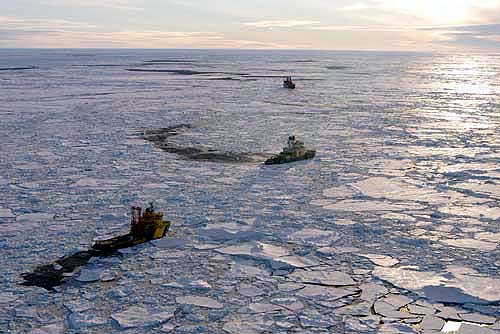 By Ned Rozell October 21, 2005
From the depths of a long ridge spanning the floor of the Arctic Ocean, researchers have pulled up evidence of a plant that now grows in rice fields in Vietnam. This suggests that the top of the world was once a very warm place. 
Moran is familiar with the present version of the Arctic Ocean, the one that's neither warm nor fresh. The University of Rhode Island professor toured Alaska in October to talk about a summer 2004 expedition in which she and her colleagues sailed to the top of the world and drilled into Lomonosov Ridge, more than 3,000 feet below the surface of the Arctic Ocean. The cores they retrieved contained reproductive spores of the azolla plant, pollen from other plants, fish teeth, fish bones, diatoms (the skeletons of ancient algae), and many other biological and geological artifacts preserved in the sediment of the ridge. The Lomonosov Ridge is 1,100 miles long, about the distance from San Francisco to Denver, and rises about 10,000 feet from the floor of the Arctic Ocean. Geologists think the ridge might have broken away from a continent about 55 million years ago and remained near the North Pole while other landmasses drifted away. Moran and other scientists chose the ridge for potential drilling during a 1991 cruise during which they crossed the North Pole. The site was intriguing for the fact that no one had ever drilled the seafloor for a core there because of sea ice that drifts around like pieces of a massive jigsaw puzzle. To fight slabs of ice acres big and up to 12 feet thick, officials with the Integrated Ocean Drilling Program arranged to allow two other ships to accompany the drilling ship. One, a colossal Russian nuclear-powered icebreaker, had the job of splitting ice shelves into pieces manageable for a smaller icebreaker. Together, the two ships pulverized drifting ice and deflected huge pieces from the drill ship. Moran's best day came when the captain of the drill ship came to her as they were drifting above Lomonosov Ridge and said, "Start drilling." "When we were able to stay on location, that was it." Moran said. "I almost cried." The captain of the drill ship held it steady about 150 miles from the North Pole for nine days, long enough for the crew to lower a drill bit through 3,000 feet of ocean and penetrate Lomonosov Ridge. The resulting core represents millions of years in the history of the Arctic Ocean, including the ferns that thrived during a "hothouse period" and pebbles known as dropstones that hitched a ride on ice floes before falling to the ridge. These pebbles, which show up in the core from about 42 million years ago, lead the researchers to believe that ice may have formed on the surface of the Arctic Ocean about then. Before the time of the azolla fern, the water of the ocean may have been about 68 degrees Farenheit, about as warm as the ocean at Jacksonville, Florida, in November. As with any project this size, the detailed work takes place not on ships in the Arctic but in labs in Bremen, Germany and elsewhere, where technicians are picking apart the core to learn more about the warm arctic and the world's distant past.
Publish A Letter on SitNews Read Letters/Opinions Submit A Letter to the Editor
|